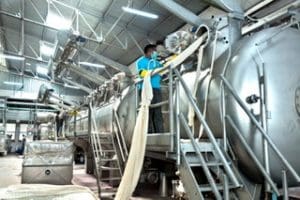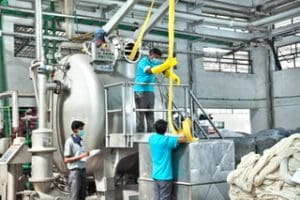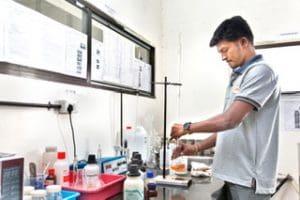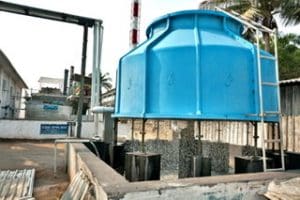Aims To Invest More On Technology
Dollar Industries Ltd, one of the top three hosiery brands of India which enjoys a 15% market share in the branded hosiery segment. Since eco-friendly manufacturing is the need of the hour, Dollar Industries’s Tirupur has become India’s First Textile Cluster to comply with zero liquid discharge guidelines. Zero-liquid discharge (ZLD) is a water treatment process in which all wastewater is purified and recycled, therefore, leaving zero discharge at the end of the treatment cycle.
Headquartered in Kolkata and has four manufacturing units in Kolkata, Tirupur (TN), Delhi and Ludhiana. Dollar Industries had Rs. Rs. 1030.96 Crore turnover for the financial year 2018 – 19. The brand has been using a renewable source of energy for manufacturing, they have invested five-megawatt wind energy farm at Tamil Nadu and a 1000 kilolitre zero liquid discharge effluent treatment plant. In an chat with Textile Value Chain, Vinod Kumar Gupta, Managing Director, Dollar Industries, speaks on the technology they had implemented.
Please explain the in detail the Zero-liquid discharge (ZLD) in your plant from idea to implementation level.
Going green and adoption of environmental friendly practices is an imperative part of an organisation. We at Dollar Industries, firmly believe that the industrial impact must be focused on. Therefore, we implemented the ZLD across our plant and manufacturing unit.
The water generated from our plant is treated chemically and biologically at our effluent 1000KL Zero Liquid Discharge plant. A bulk of this treated water is reused in our factory while the remaining quantity goes into watering plants and landscaping the area. The remaining extreme discharge is evaporated to make the waste to zero. Additionally, all the sludge is disposed responsibly at a Government appointed disposal site.

What were the initial challenges you had faced while implementing this and how did you manage to complete this?
While adopting environmental practices is important, large scale companies often face a number of teething issues. Firstly, the RO process of industrial waste water needs to remove harmful solids properly. The accumulated deposits also need to be treated efficiently, or it could lead to clogging, causing utmost damage to the entire system. So we had to make sure that the system is fluent as well as energy efficient.
ZLD is a chemical based process and the usage of adequate amount is often a tricky art. We need to be extremely careful and use minimal chemicals to treat the water. Since the level of contamination differs, we need to be extremely careful and the process needs to be monitored thoroughly.
The evaporation process in the last stage of ZLD, and is the most critical due to extreme discharge causing serious environmental impact. Very delicate processing and containing of the last unusable quantity of waste water is not just difficult but very important for the ZLD to complete a cycle. It is true that the most expensive part of the ZLD treatment plant is the evaporation.

How do you compare the factories in India and their counterparts in managing water? Where do Indian companies stand in terms of water management?
While the ZLD technology has been available and a mandatory practice across industries in Europe since the 1980s, in India it is relatively a newer practice. Very often, ZLD involves high capital investments and operation costs. These are often a threat to industry survival as few industries fail to bear the cost of the entire process. A number of industries in India are often notified for non-compliance that have also led to closing the factories and operations.
One of the major challenges in adopting ZLD technology is that there are no standard process. While the end result is the same, the process along with the terms and conditions, often varies from industry to industry. The system also often needs up-gradation as per the changes in usage of various chemicals. This is again complex and effects cost of operations.
However, newer technologies are coming up to make the entire process cost efficient and also reduces energy usage.

Post-implementation of the ZLD plants, what are the key transformations you notice in your production without compromising the quality and production quantity?
Our ZLD plant is based in Tamil Nadu, where water crisis is not a hidden fact. So, it is a solace to be able to reuse the once used water. Not only does it help us saving water from environmental impact but it boosts production capacity.
Meanwhile, we earn carbon credits, through our contribution – which is useful to the company in various ways.

What are your top 3 suggestions for your colleagues in the hosiery sector who are looking at having a ZLD in their organization?
Firstly, water resources are becoming scarce and therefore, we have to opt for reuse options. ZLD is an emerging and efficient technique to achieve the goal of minimising waste, treat industrial toxins, recover resources and also impact fresh water quality. Textile industries are one of the highest contaminated waste water generators, and therefore it is our responsibility to do our best to save the environment.
Secondly, we have to be individually responsible to clean up our wastes. With the help of our government, smaller players in the segment can also opt for ZLD technology.
The capacity of the ZLD is crucial to the amount of production involved. Companies with higher investment in backward integration must necessarily get it.

Your quote on the innerwear sales decline was making news recently. Do you see the situation is the same even now?
The hosiery/innerwear segment is seasonal. It is not something that individuals buy on a day to day basis. The sales are subjective to seasonal changes, festivities, and other peak seasons like holidays or weddings. The segment has definitely seen a slow down or a dent, due to current situations known to us. But in the long run sales figures shall not be impacted.

Today many companies which were focussing only on the export business have started exploring India as a market. Do you think that competition is increasing within India?
India as a market is always attractive. Particularly the middle class youth, who are willing to experiment and are aspiring too. There shall be some kind of business for all such brands eyeing Indian market.
However, the most difficult part is the pricing. Despite competition, Indian brands like us with value for money products shall always be in demand.

Other than water and energy what are the other key investments you had made in terms of technology?
Our in-house Spinning and Knit Processing Division, are key investments in our consolidation of backward integration. The Knits Processing Division is installed with latest technology and lab equipment, having production capacity of 500 tons/month, with eco-friendly dyes and chemicals.

When it comes to procurement of machinery for manufacturing what are the top aspects you look at machines?
Automation in crucial now-a-days, while choosing machineries’. Labour is slowly evolving to be a big concern both in availability and cost. So, with automation, this concern can be addressed and resolved in coming days.

Today you have a 15% market share in India and your exports are also good. Where are you planning to invest in?
We are now concentrating on our supply-chain improvement. In spite of progressing and multiplying our turnover in last one decade, we have seen there is a huge gap in the market.
We have 900 plus distributors and are present in 1 lakh MBOs. Yet, our reach is less than half of the total market in India. India is 35 percent Urban and 65 percent as rural. We have to prepare ourselves for the growing markets in both geographies.


